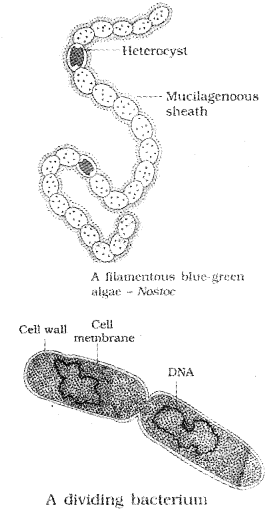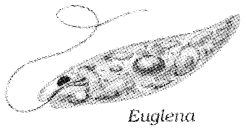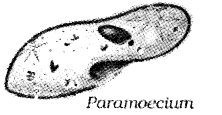Kerala Plus One Botany Notes Chapter 1 Biological Classification
Two kingdom classification:
- It was proposed by Linnaeus, include two Kingdoms-Plantae & Animalia.
- In two kingdom classification following things are not considered
Cell structure, nature of wall, mode of nutrition, habitat methods of reproduction and evolutionary relationship.
Five kingdom classification:
- It was first proposed by R H.Whittaker (1969).
- It includes Monera, Protista, Fungi, Plantae and Animalia
- Blue green algae are placed in kingdom Monera.
- Chlamydomonas, Chlorella with Paramoecium and Amoeba are placed in kingdom protista
- Chlorophyll less and non cellulosic (chitin)type plants are placed in kingdom Fungi
- All photosynthetic plants are placed in-kingdom plantae
- All animals with mode of nutrition(ingestion) placed in kingdom animalia.
- The characteristics of classification are
| 1. Cell structure 2. Thallus Organization 3. Mode of nutrition 4. reproduction and 5. Phylogenetic relationships |

Kingdom monera:
Types of bacteria:
Based on shape, bacteria are of 4 types
- Spherical – Coccus
- Rod – shaped – Bacillus
- Comma – shaped – Vibrium
- Spiral – Spirillum.

Based on nutrition, bacteria are of 3 types:
- Photosynthetic autotrophic: Bacteria can synthesise their own food by using chlorophyll in the presence of light.
- Chemosynthetic autotrophic: Bacteria can synthesise their own food from inorganic substrates.
- Heterotrophs: They are depend on other organisms for food.
Archaebacteria:
- These bacteria can live in extreme conditions.
- Its cell wall structure is different from other bacteria
Types of archaebacteria:
- Halophiles: They are found in salty areas
- Thermoacidophiles: They are found in hot springs.
- Methanogens: They are found in marshy areas and guts of ruminant animals eg-cows, buffaloes etc.
Importance in industry:
They are responsible for the production of methane (biogas) from the dung.
Eubacteria Cyanobacteria (blue-green algae):
- They have chlorophyll a similar to green plants called as photosynthetic autotrophs.
- Some of them found in polluted water bodies.

Significance of cyanobacteria:
They can fix atmospheric nitrogen in specialised cells called heterocysts and increases fertility of soil eg: Nostoc and Anabaena
Chemosynthetic autotrophs:
They oxidise various inorganic substances such as nitrates, nitrites and ammonia and use the released energy for their ATP production.
Significance chemosynthetic autotrophs:
They play a great role in the recycling of nutrients like nitrogen, phosphorous, iron and sulphur.
Heterotrophic bacteria:
- They depend upon others for getting energy.
- Most of them are decomposers.
- They are helpful in making curd from milk, production of antibiotics, fixing nitrogen in legume roots, etc.
Disease caused by bacteria:
Some are pathogens causing disease to plants and animals, eg: Cholera, typhoid, tetanus, and citrus canker in plants.
Cell division in bacteria:
Reproduction:
- Bacteria reproduce mainly by fission.
- Some bacteria produce spores during unfavourable conditions.
- In sexual reproduction, transfer of DNA from one bacterium to the other takes place
Mycoplasmas:
Salient features:
- They are the smallest living cells can survive without oxygen
- They are pathogenic in animals and plants
- They lack a cell wall.
Kingdom Protista:
Salient features:
- They are single-celled eukaryotes.
- Their cell body contains a well defined nucleus and other membrane-bound organelles.
- They are mainly aquatic.
Types of protist:
The kingdom include chrysophytes, Dianoflagellates, Euglenoids, Slime moulds and Protozoans.
Chrysophytes:
- They are diatoms(chief ‘producers’ in the oceans) and golden algae (desmids).
- Most of them are photosynthetic.
Salient features:
- In diatoms the cell walls form two thin overlapping shells,which fit together as in a soap box.
- Their cell wall contain silica
Economic value:
Their cell wall deposited in ocean floor over billions of years in large amount called as ‘Diatomaceous earth’. It is used in polishing, filtration of oils and syrups.
Dinoflagellates:
Salient features:
- They are marine and photosynthetic
- Most of them have two flagella one lies longitudinally and the other transversely.
Harmful effects:
- Red dianoflagellates -Gonyaulax undergoes rapid multiplication and sea appear red (red tides).
- Toxins released by them kill other marine animals such fishes.
Euglenoids:
Salient features:
- They are fresh water organisms found in stagnant water.
- Pigments of Euglenoids are identical to those of higher plants.
- They have a protein rich layer called pellicle which makes their body flexible.
- They have two flagella, a short and a long one.
Mode of nutrition:
They are photosynthetic in the presence of sunlight (autotrophic) and predating on other smaller organisms in the absence of sunlight (heterotrophs). Hence nutrition is mixotrophic. Example: Euglena.

Slime Moulds:
Salient features:
- They are saprophytic protists.
- They form an aggregation during favourable conditions called plasmodium which may grow and spread over several feet.
- The plasmodium differentiates and forms fruiting bodies bearing spores at their tips during unfavourable conditions.
- They are resistant and survive for many years under adverse conditions.
Protozoans:
They are heterotrophs and live as predators or parasites.
Type of protozoans:
1. Amoeboid protozoans:
- They live in freshwater or sea water
- They capture their prey by pseudopodia (false feet) as in Amoeba.
- Some are parasites as in Entamoeba
2. Flagellated protozoans:
- They possesss flagella.
- The parasitic forms cause diseases such as sleeping sickness. Example: Trypanosoma.
3. Ciliated protozoans:
- They are aquatic and have a cavity (gullet) that collect food from outside.
- They move with the help of cilia. Example: Paramoecium.
4 Sporozoans:
They are infectious due to the spore-like stage in their life cycle. eg: Plasmodium (malarial parasite) which causes malaria.

Kingdom Fungi:
They are heteterotrophs, mainly 2 types
- Saprophytes: They can absorb soluble organic matter from dead substrates
- Parasites: They are depend on living plants and animals
Symbiotic associations:
- Lichens-Fungi forms an association with algae
- Mycorrhiza-Fungi forms association with roots of higher plants.
Disease caused bv fungi:
They cause diseases in plants and animals. eg: wheat rust disease by Puccinia.
Salient features:
- Yeast is unicellular fungus but others are multicellular.
- Mycelium: lt is body of fungi contains many hyphae
- Hyphae It is the long, slender thread-like structures
- Some hyphae with multinucleated cytoplasm are called coenocytic hyphae.
- Others have septae or cross walls in their hyphae. eg: Penicillium.
- The cell walls of fungi are composed of chitin and polysaccharides
Types of Reproduction:
- Vegetative method: It takesplace by fragmentation, fission and budding.
- Asexual method: It takesplace by spores called conidia orsporangiospores or zoospores.
- Sexual reproduction: It takesplace by oospores, ascospores and basidiospores.
- The spores are produced in special structures called fruiting bodies.
Steps of sexual cycle:
| (i) Fusion of protoplasms between two motile or non-motile gametes called plasmogamy. (ii) Fusion of two nuclei called karyogamy. (iii) Meiosis in zygote resulting in haploid spores |

In this, two haploid hyphae come together and fuse results in diploid cells (2n).
Dikarvotic stage in funai:
- In ascomycetes and basidiomycetes, after plasmogamy dikaryotic stage (n + n ) occurs for some time. Later these nuclei fuse and the cells become diploid.
- The fungi form fruiting bodies in which reduction division occurs and forms haploid spores.
Phvcomycetes:
Salient features:
- They are found in aquatic habitats and on decaying wood.
- Their mycelium is aseptate and coenocytic.
Types of reproduction:
1 Asexual reproduction:
It takes place by zoospores (motile) or by aplanospores (non-motile). These spores are produced in sporangium.
2 Sexual reproduction:
It is the fusion of gametes have similar structure (isogamous) or dissimilar structure (anisogamous or oogamous) and after fusion zygospore is formed. Examples are Mucor, Rhizopus (the bread mould) and Albugo (the parasitic fungi on mustard).
Ascomycetes:
Salient features:
- They are commonly known as sac-fungi, eg-unicellular- yeast (Sacharomyces) or multicellular Penicillium.
- Some are coprophilous (growing on dung).
- Mycelium is branched and septate.
- The asexual spores are conidia produced on conidiophores.
- Sexual spores are called ascospores which are produced in sac like ascus.
- Spores are arranged in fruiting bodies called ascocarps.
- Examples are Aspergillus, Claviceps and Neurospora.
Economic value:
- Neurospora is used in genetic studies.
- Edible members are morels and buffles.
Basidiomycetes:
Salient features:
- Their mycelium is branched and septate.
- Some members grow as parasites and disease causing organisms e.g. rusts and smuts
- Common basidiomycetes are mushrooms, bracket fungi or puffballs
Reproduction:
- The asexual spores and sex organs are not found but vegetative reproduction by fragmentation.
- In sexual reproduction, plasmogamy occur by fusion of two vegetative cells of different strains. It results dikaryotic mycelia which gives rise to basidium. Later, karyogamy and meiosis takeplace in the basidium and producing four basidiospores.
- The basidia are arranged in fruiting bodies called basidiocarps.
- Examples -Agaricus (mushroom) Ustilago (smut) and Puccinia (rust fungus).
Deuteromvcetes:
Salient features:
- They are called as imperfect fungi because perfect stage or sexual reproduction is absent.
- Their asexual reproduction takes place with the help of conidia. ,
- The mycelium is septate and branched.
Economic value:
- Some members are decomposers play an important role in the mineral cycling.
- Examples are Alternaria, Colletotrichum and Trichoderma.
kingdom Plantae
- Majority members are eukaryotic, chlorophyll-containing organisms.
- Few members are partially heterotrophic- insectivorous plants or parasite. eg: Bladder wort and Venus fly trap are examples of insectivorous plants and Cuscuta is a parasite.
Different types of plant group:
The kingdom Plantae includes algae, bryophytes, pteridophytes, gymnosperms and angiosperms.
Life cycle:
It has two distinct phases – the diploid sporophytic and the haploid gametophytic – that alternate with each other.
Kingdom Animalia:
Salient features:
- It includes heterotrophic eukaryotic organisms.
- They are multicellular and their cells lack cell wall.
- Their mode of nutrition is holozoic (ingestion of food).
- Most of them are capable of locomotion.
Viruses, Viroids And Lichens:
R.H. Whittaker not placed acellular organisms such as viruses, viroids and lichens in five kingdom classification.
VIRUSES:
Historical aspects and Discovery
- Name virus that means venom or poisonous fluid was given by Pasteur D.J. Ivanowsky.
- Extract of the infected plants of tobacco could cause infection in healthy plants and called the fluid as Contagium vivum fluidum (infectious living fluid).It was identified by M.W. Beijerinek (1898)
- Viruses could be crystallised and crystals consist of proteins outside. It was identified by W.M. Stanley. (1935)
Salient features:
- Viruses are non living particle outside the living cell.
- It has an inert crystalline structure .
- They have living state inside the host and multiply by using host cell machinery-Ribosome. So they are called as obligate parasites.
- They are smaller than bacteria because they passed through bacteria-proof filters.
Structure of viruses:
Viruses contain proteins coat outside, either RNA or DNA inside, (i.e either single or double stranded RNA or double stranded DNA).
| The Protein coat called capsid made of small submits called capsomeres, protects the nucleic acid. |
Symptoms and disease caused by viruses:
Disease:
Mumps, smallpox, herpes, influenza and AIDS
Symptoms in plants:
| Mosaic formation, leaf rolling and curling, yellowing and vein clearing, dwarfing and stunted growth. |
Viroids:
Strucure:
It has free RNA without protein coat.
Discovery:
T .O .Diener found that this infectious agent was smaller than viruses.
Disease:
It causes potato spindle tuber disease
Lichens:
They are symbiotic associations between algae and fungi.
Types of component:
- The algal component is called phycobiont: (autotrophic) prepare food for fungi
- The fungal component is called mycobiont: (heterotrophic) provide shelter and absorb mineral nutrients and water for algae.
Significance:
Lichens are very good pollution indicators i.e they do not grow in polluted areas.

Ncert Supplementary Syllabus
Six kingdom classification:
It was proposed by Carl Woese. It includes kingdoms like Archaebacteria, Eubacteria Protista, Mycota, Plantae and Animalia.
